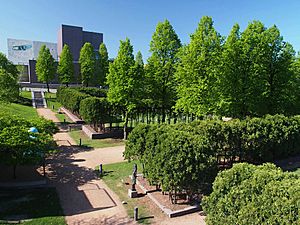Minneapolis Sculpture Garden facts for kids
Quick facts for kids Minneapolis Sculpture Garden |
|
|---|---|
 |
|
| Type | Sculpture park |
| Location | Minneapolis, Minnesota, United States |
| Area | 11 acres (4.5 ha) |
| Created | 1988 |
| Operated by | Walker Art Center, Minneapolis Park and Recreation Board |
The Minneapolis Sculpture Garden is a large park in Minneapolis, Minnesota, United States. It covers about 11-acre (4.5 ha) and is a fun place to see amazing art outdoors.
The garden is right next to the Walker Art Center. The Walker Art Center works with the Minneapolis Park and Recreation Board to manage the garden. In 2017, the garden was updated. It joined with the Walker Art Center to create a bigger 19-acre area. It is one of the largest city sculpture gardens in the country. You can find 40 permanent art pieces there. There are also other artworks that change from time to time.
Contents
History of the Garden
The land where the garden now sits was bought by the park board a long time ago. This was around the early 1900s. People called it "The Parade" because it was used for military drills. Later, it became known as the Armory Gardens. This was after Theodore Wirth, a park superintendent, designed it. His design included a U.S. National Guard armory for soldiers.
From Flowers to Art
In 1913, the land was changed into beautiful floral gardens for a flower convention. It stayed a flower garden for the next 50 years. In 1934, the old armory building was taken down because it was not safe. A new armory was built in downtown Minneapolis. This meant the Armory Gardens became part of the Minneapolis Park Board.
Before the Sculpture Garden opened, the area was used for sports. There were playing fields and a stadium built in 1950. The Minneapolis Sculpture Garden officially opened in 1988. It was designed by Edward Larrabee Barnes and landscape architects Quinnel and Rothschild. The stadium was removed in 1990. Two years later, the garden grew by another 3.5 acres (1.4 ha). This new part was designed by Michael Van Valkenburgh and Associates, Inc. It has an open area with a walkway and the 300-foot-long (91 m) Alene Grossman Memorial Arbor.
Famous Artworks and Features
The most famous artwork in the garden is the Spoonbridge and Cherry. This fun fountain was created between 1985 and 1988. It was designed by a husband and wife team, Claes Oldenburg and Coosje van Bruggen.
The Irene Hixon Whitney Bridge
The Irene Hixon Whitney Bridge was built in 1988. It was designed by Siah Armajani. This bridge crosses over Hennepin Avenue and I-94. It connects the sculpture garden to Loring Park for people walking. The bridge was fixed up in 2018. The wooden deck was replaced, and the bridge was repainted. A poem by John Ashbery is written on the bridge beams in metal letters. These letters were also replaced. The bridge was repainted in colors that matched the original design. Lights were also added to the bridge. These lights were part of the first design but were not put in at that time. Staff at the Walker Art Center joke that the poem is the "longest poem in the world." This is because the bridge stretches over 16 lanes of traffic for 375 feet (114 m).
Garden Updates and New Art
In 2016 and 2017, the garden was rebuilt. This was done to help manage water better. The area used to be a marsh. A special tank was put near Spoonbridge and Cherry to collect water. This water is used for the garden and nearby sports fields. Other improvements were made too. Vineland Place, the road between the Walker Art Center and the garden, was made narrower. The restrooms were also updated. After this reconstruction, the Walker Art Center added 18 new artworks to the garden. One of these is a special sculpture by Theaster Gates called Black Vessel for a Saint. It is his first permanent outdoor sculpture.
Notable Installations
- Spoonbridge and Cherry (Claes Oldenburg and Coosje van Bruggen)
- Hahn/Cock (Katharina Fritsch)
- Wind Chime (Pierre Huyghe)
- Shadows at the Crossroads (Seitu Jones, Ta-coumba Aiken, Soyini Guyton)
- Okciyapi (Help Each Other) (Angela Two Stars)
See also
 In Spanish: Jardín de esculturas de Mineápolis para niños
In Spanish: Jardín de esculturas de Mineápolis para niños

